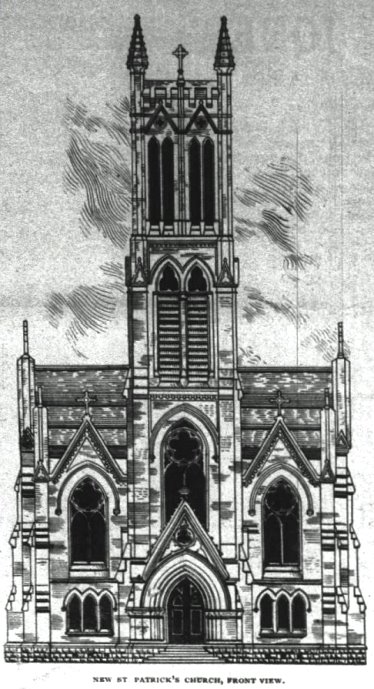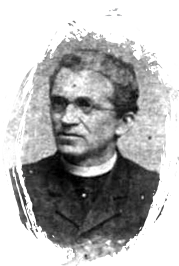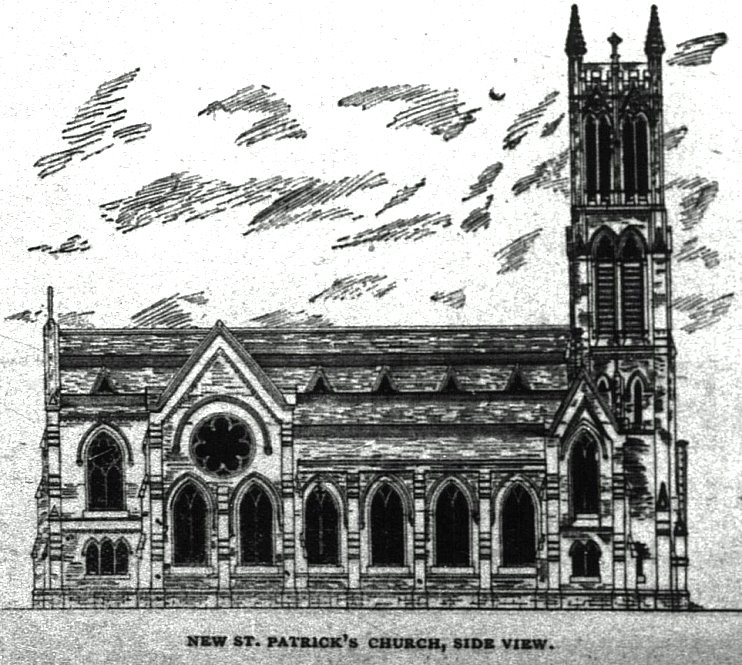|
St. Patrick's Catholic Church Denison, Texas  The Sunday Gazetteer Sunday, December 11, 1898 pg. 3 THE NEW CATHOLIC CHURCH An Enduring Monument to the Liberality of our Catholic Citizens A Description of the New Edifice with Some Historical Data - Dedication Services To-Day (Sunday), December the 11th. The history of St. Patrick's Church to be dedicated to-day (Sunday) is co-eval with the history of Denison. It had a modest beginning, but has kept pace with every step that Denison has taken forward to her present growth and greatness. Churches to a great extent are like individuals, they have their ups and downs, their seasons of prosperity and depression, and St. Patrick's is no exception to the rule. For over 20 years the Catholic population have worshiped in the wooden edifice at the corner of Sears street and Rusk avenue. The saddest and the most joyful associations of two decades are associated with the little church at the corner. Out of its sacred portals have been carried the dead, and in the shadow of the altar have been spoken those words which have made so many young hearts happy. The old church will never grow less in memory, and the new edifice can never take away the reverent love for the old landmark. There will be many, many sad farewells when for the last time the worshipers shall gather beneath the roof of old St. Patrick's. It has been a mecca to their souls. When all the world has turned against them, the portals of St. Patrick's were open to receive them and give them that blessed consolation which could be found no where else. At some future time when the history of the Catholic movement in Denison is written, there will be no more interesting chapter than that descriptive of the scenes and incidents that are associated with the old edifice. The Catholic church has grown wonderfully in Denison. The old church being wholly inadequate to accommodate the congregation, and the building of a new church was a necessity. HISTORICAL We regret that we have not more material at hand to give the readers of the Gazetteer the early history of the Catholic church in Denison. Many who could furnish the facts are dead, while others have been called to distant fields of action. While the writer has been a resident of Denison for over twenty-five years, he was obliged to go to the old Catholics for the information furnished, and even they were a little rusty as to the pioneer history of their church, and what we write forms indeed but a small portion of an interesting history of a church that has emerged from a small beginning to a great present. The first Catholic service in Denison was in 1872, when Father Martiniere, now of Dallas, celebrated Mass in a room where the State Hotel stands. A church was built in the spring of 1873. The original structure was enlarged in 1877, by a transept built by Rev. Francis Derue. The succession of priests was as follows: Revs. Father Martiniere, Thion, Quinon, Truchard, Guyot, Derue, Buffard, Logue, Blum, and the present pastor, who took charge in January, 1890. The new church, designed by Architects N.J. Clayton & Co., who have designed and superintended the construction of the finest churches and public buildings in the South, will be a lasting monument to the liberality of all who have contributed to its construction. To Mr. J.D. Quinn special praise is due, who, to his donation of $5000, added a loan of $6000. The foundation was laid in 1896; the corner stone, the last Sunday of July, 1897. The roof and ceiling are a masterpiece of workmanship, executed under the superintendence of M.J. Leonard, by one of the best mechanics in the country, Ed. Fleetwood. The slating, guttering and galvanized iron work, done by Beatty & Mazzie, shows skilfull workmanship. The painting is very satisfactorily done by Tabor and Horston. Mr. Shelton has done good work on the plastering. The work has progressed slowly, but there was never a more complete structure in harmony and detail. Architect M.J. Leonard who has been connected with the building of the noble edifice has furnished the with the following details: "Length of building 149 feet; width, 68; height of ceiling, 65; height of tower, 145; seating capacity including transepts and gallery, 1,200 to 1,600. The plan is Gothic, and is the church of the pointed arch par excellence. At first sight the plan of the nave seems so complicated as to defy all attempts at comprehension, but a few moments' contemplation and it resolves itself into a unity, whose simplicity and elegance delight bot the eye and the understanding. The windows between the buttresses are exceedingly beautiful. Piercing the walls in three or four consecutive stories separated by entablatures, they are bounded by receding arches of rich and varied design. Single or clustered columns usually separate them into three divisions and these are filled with elegant geometric tracery and handsome emblems of art glass. These magnificent rose shaped windows, massive capitals and vaulted arches, give that enthusiastic, aspiring freedom, the life and boldness of the Gothic. The noble groined vault, so beautiful in the endless variety of its lines, and yet so complete in its unity that not a single piece could be spared, every part an ornament and yet every part essential. The various stories are separated by cornices, and the pilasters which are arranged in groups, fill the space between the windows and rest upon pedestals arising from these. A Roman cornice crowns the whole facade, which is unsurpassed in simplicity of arrangement, harmony of parts and nobleness of proportions. The angels with extended wings perched between intersections of the second story arches seem to triumphantly express the sentiments of a living faith. Gables and pennacles surmount the windows on all sides, and these, together with the pennacled buttresses, slender tower arising at the intersection of the cross, flying arches and ornamental balustrades, give such multiplicity of detail, such varied and ever changing outline, as almost to bewilder the imagination, so minute and delicate appear all the details and so complete and harmonious the whole, that it seems as if a hand more spiritual and tender than that of man must have fashioned its wondrous parts."  It is eminently proper to say something of the beloved pastor, Rev. Father Crowley.
He has, to put it literally, watched and prayed with the new
church. On his shoulders have fallen grave responsibilities,
duties nobly performed. He has been the inspiration of the grand
edifice. He has watched every detail with a loving vigilance that
never ceased. He has toiled unceasingly day by day, week by week
and month by month, and he has seen the grand pile grow to completion.
The people of Denison, and even those most near to the Father,
will never know the tremendous responsibility that has devolved on him,
but with superior executive ability he has always proved equal to that
occasion. We hope that he may long be spared to the church. The church work of Father Crowley has been acceptable to all. Under his spiritual guidance, luke-warmness has been dispelled, and St. Patrick's was never stronger than to-day in the affections of its members. Service at St. Patrick's church Sunday, Dec. 11th, will be as follows: 10 a.m., blessing of new church by Bishop Dunne of Dallas, assisted by the priests Pontifical High Mass immediately after the blessing of the church celebrated by Rt. Rev. Theo. Meerchaer, Bishop of the Indian Territory, assisted by the clergy present. The sacrament of confirmation will be administered to a class of 70 persons at 3 p.m., by Bishop Dunne. 7:30 p.m. Vespers and sermon by Bishop Meerschaert All seats free and the public cordially invited to all the services. In blessing the church the Bishop and clergy sing four appropriate Psalms with prayers and march around the church, the Bishop meanwhile sprinkling the walls with holy water.    St. Patrick's Catholic Church History Susan Hawkins © 2024 If you find any of Grayson CountyTXGenWeb links inoperable, please send me a message. |